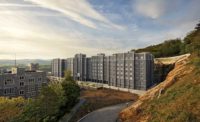Owner U.S. Army Corps of Engineers, NY District
Architect and Engineer of Record Clark Nexsen
General Contractor Walsh Construction
Design Architect STV/URS Joint Venture
Geotechnical Surveying Tectonic Engineering & Surveying Consultants
Commissioning Agent AECOM Technical Services Inc.
Davis Barracks, the first barracks built at the U.S. Military Academy at West Point in 45 years, is a design-build project that was completed in 2017 for $183 million—$3 million under budget. The six-story, 287,000-sq-ft, military-gothic-style structure is faced with 167,901 individually shaped granite blocks for long service life, ease of maintenance and to help the post maintain its nearly 60-year designation as a national historic landmark.
But within the historic styling, the building has many complex, innovative and sustainable features—including a six-story central lightwell for daylighting, radiant heating and cooling, and 100% solar domestic water heating in support of the academy’s goal of a net-zero energy campus. The building is performing with an energy use intensity rating that is 39% better than solicitation requirements, says the submitter. Project engineers note the heating and cooling system is completely within floors and walls, which frees space and improves flexibility. They say the system is one of only a few in the country, and its performance will inform future design, particularly in cold weather regions.
They also say Clark Nexsen’s engineered solution of specialty sprinklers and horizontal exits, which made it possible to build the glazed lightwell without expensive fire rated glass, also will likely serve as a precedent for future designs in which extensive glazing is desired for aesthetics and daylighting.
The barracks house 650 cadets and have study and meeting rooms, a formations area and infrastructure for a new central utility plant. The highly constrained site required blasting and drilling to establish a level field 700-ft by 380-ft over a 132-ft grade change without disturbing activities in adjacent buildings. Design and construction teams fully integrated COBie life-cycle operations and maintenance data in the building information model.
Judges praised Walsh’s craft quality and safety protocols, which yielded a recordable incident rate of 2.91 and lost-time accident rate of 0.68.






Post a comment to this article
Report Abusive Comment